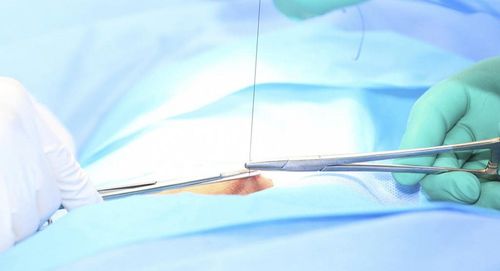This is an automatically translated article.
The article is professionally consulted by Specialist Doctor II Huynh Thi Hien - Obstetrician and Gynecologist - Department of Obstetrics and Gynecology - Vinmec Nha Trang International HospitalStillbirth is quite rare, with an incidence of 1 in 200 pregnancies. Diagnosis of stillbirth is often based on the results of routine antenatal care instead of symptoms, because there are no specific warning signals of the disease to the outside. After confirming that the baby is dead, despite the grief, the mother still needs to conduct treatment for the stillbirth, mainly to find a way to get the fetus out.
1. How to diagnose stillbirth?
Periodic prenatal check-ups will help doctors assess the health of the fetus, detect abnormalities, including stillbirth.
If the pregnant mother is at risk of stillbirth or feels a change in the baby's movements and suspects that the fetus is dead, then to diagnose stillbirth correctly, the doctor will listen to the fetal heartbeat with a handheld Doppler stethoscope, then a fetal ultrasound can be performed to confirm.
Besides, the Non-stress test can also be performed to record the fetal heart rate and compare the fetal heart rate response to fetal movements during the last 3 months of pregnancy (from week 28 onwards). .
When the results confirm that the fetus is dead, the mother can still feel the fetus move, which usually happens when the pregnant woman changes position. At this time, the doctor will appoint the pregnant mother to perform another ultrasound.
The discovery of stillbirth will be a big shock for parents. Ask your doctor to explain this result and guide you on how to manage the stillbirth.
2. Treatments for stillbirth
After the results confirm that the fetus is dead before birth, the pregnant woman is usually given medicine to induce labor, in order to expel the stillbirth. This method is safer for the mother than surgery.If it is not imperative to bring the baby out immediately (due to medical complications), you can wait for natural labor. However, the birth of the baby should be carried out in the near future.
The decision about induction of labor or spontaneous labor does not need to be made immediately, but the mother can go home 1-2 days before returning to the hospital for treatment.
In some cases, a pregnant woman will be recommended to use medication to prepare for the expulsion of stillbirth.
Specific stillbirth management options are as follows:
2.1 Spontaneous labor If it is decided to choose to wait for spontaneous labor, the pregnant woman will be assigned a routine blood test every 48 hours.

2.2 Induction of labor If the mother has serious health problems, induction of labor using drugs is almost mandatory, even done immediately if the pregnant woman has the following conditions:
Money severe eclampsia; Serious infections; Amniotic fluid rupture. Oral induction of labor can also be done by inserting a pill or gel into the vagina. In some cases, the medication is given through a vein in the arm.
3. Problems mothers need to face after finishing stillbirth treatment
3.1 What to do with a dead fetus What parents need to do after a stillbirth is a personal decision, and there is no definite right or wrong answer to actions. there.
After the baby is born, parents may want to look and hold the baby. That depends entirely on your feelings and decisions. If necessary, ask everyone to give themselves a quiet space with their children.
You can also take a photo of your baby and keep mementos such as a lock of hair, footprints/fingerprints or the scarf wrapped around the baby. Besides, some parents will also want to name their baby. This is a common practice that has been around since the 1980s, and it is believed that doing so will help alleviate the loss of parents.
3.2 Breast milk problems Even after the fetus is dead, a woman's body will still produce milk and this can cause discomfort, adding to the feelings of grief for the mother.
Pregnant women will be given some medicine to help stop the breast from producing milk. These drugs have relatively few side effects and can help the mother emotionally, but should not be given to mothers with preeclampsia.
Besides, there are also some mothers who want to let the milk dry out on its own without using drugs. The choice is up to the mother based on the advice of the doctor.
3.2 Find the cause of stillbirth Pregnant women will be offered tests to find out the cause of stillbirth. Although finding a cause is not required, based on these results, a woman can take steps to reduce the risk of stillbirth in the next pregnancy.
Tests for the cause of stillbirth may be ordered including:
Blood tests: To determine if the mother has conditions such as pre-eclampsia, obstetric cholestasis or gestational diabetes; In-depth examination of the umbilical cord, membranes and placenta - the tissues that connect the mother's body to the fetus; Tests for infections: Urine, blood, or vaginal/cervical cells may be tested; Thyroid function test : See if the mother has thyroid diseases; Genetic testing: Usually done on a small sample of the umbilical cord, to determine if the fetus has genetic diseases (eg Down syndrome).

More specialized tests may also be done on the baby after birth, to try to find the cause of death and also the factors that contributed to the death. This process is called an autopsy.
3.3 Deciding on an autopsy of the fetus A fetal autopsy is an examination of a baby's body to provide additional information to explain why the fetus died before birth. This is especially important if the woman is planning to become pregnant in the future.
An autopsy is required to obtain the written consent of the mother.
The autopsy process includes: detailed examination of organs, looking at blood and tissue samples, performing genetic testing to see if the baby has a genetic disease.
Parents should ask medical professionals to thoroughly explain the matter of an autopsy before deciding whether to allow it.
3.4 Health monitoring A woman will usually have an appointment with her doctor a few weeks after the stillbirth treatment is over. The appointment is to re-examine her health and to announce the results of the mother's tests as well as the results of the autopsy (if performed). This is also an opportunity for the woman to discuss the possibility of future pregnancies with her doctor.
3.5 Coping with the pain of a stillbirth A stillbirth can be a huge emotional shock to parents as well as other family members. Many people experience guilt or fear after losing a child. Some parents even suffer from depression or have post-traumatic stress disorder (PTSD) - an unstable mental state caused by a major trauma in the past.
Remember that birth defects are rarely caused by things you did or didn't do. Feelings of grief, anger or guilt are normal. Seek counseling from a mental health professional, or join a group that allows you to share your feelings of losing a child with other parents. Talking about those feelings will help you feel better.
Pregnant women with signs of stillbirth or who are at high risk of having this pregnancy complication, can go to Vinmec International General Hospital for timely examination, diagnosis and intervention. There is a team of well-trained, experienced and qualified obstetricians and gynecologists; system of modern equipment, meeting international standards; Professional service quality, high efficiency in diagnosis and treatment, comprehensive health for both mother and baby.
Please dial HOTLINE for more information or register for an appointment HERE. Download MyVinmec app to make appointments faster and to manage your bookings easily.
Reference source: webmd.com; nhs.uk














